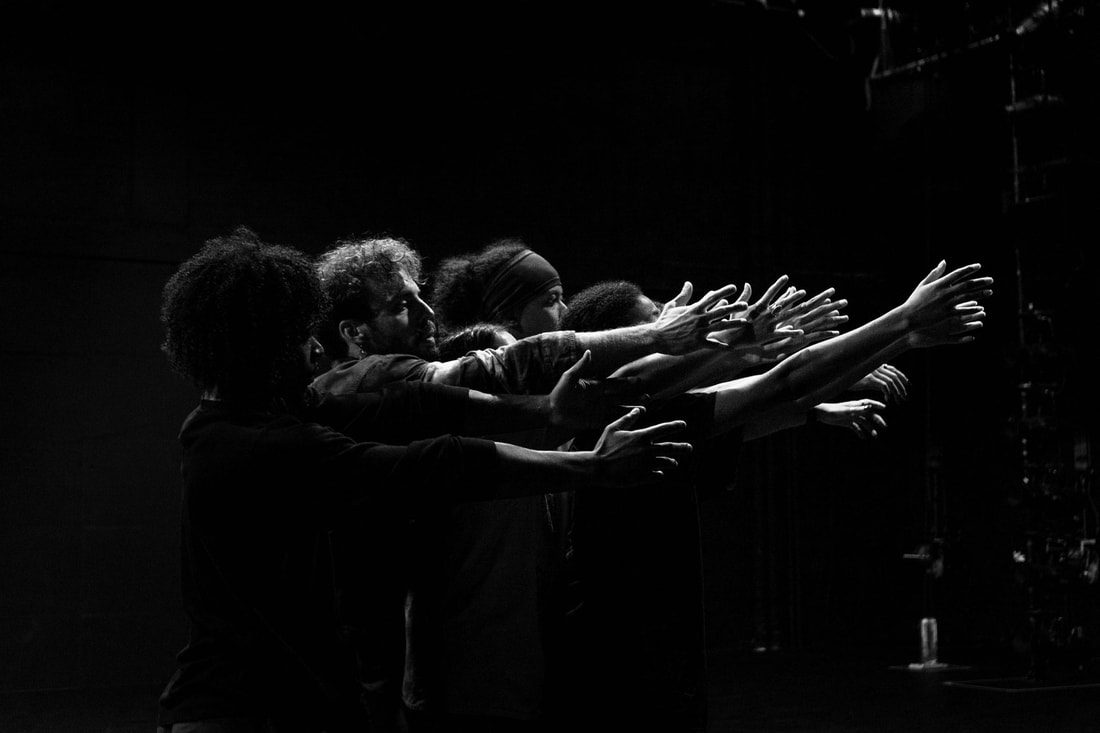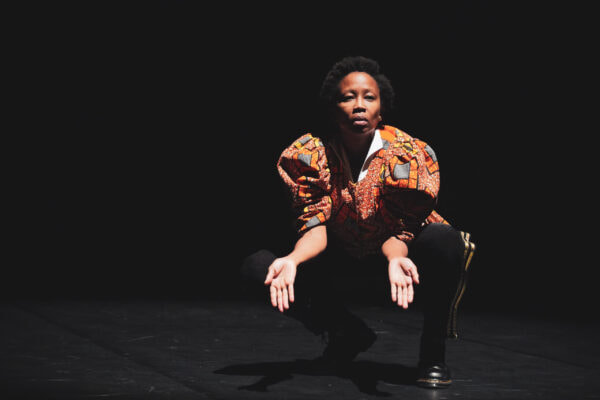|
"Evidence of Labor: State of the Kitchen" takes a chaotic approach to the heart of the home. The kitchen is many things. For the sentimental, the kitchen prompts memories of warmth, nourishment, enticing aromas. The heart of the home.
But it also has a nexus for social and, ultimately, political power -- the woman’s domain, the arena for table talk and the portal to hand down heritage. Anyway you look at it, the kitchen provided much fodder for Michelle Ellsworth and Satchel Spencer's performance piece “Evidence of Labor: State of the Kitchen.” Their plywood kitchen, erected at EMPAC in Troy on Friday night, was a room of chaos where salt was generously sprinkled by climbing, crawling and cabinet-slamming performers. And despite much contemplation, it’s difficult to lift the veil of the work that combines movement, a rambling word salad and video. As I walked about this performance, I kept thinking it would combine into something hearty and healthy, for example, a recipe for life, but it never arrived. Perhaps that is the point. The program notes tells us the creators see kitchens as socially and technically complex. Maybe they are too hard to understand – like their hour-long work. Here’s a basic description that might help the reader understand what was happening. It opens with a man holding an alpine horn that is blasting. (He is not blowing into it.) He stands next to the wooden kitchen in which dancers, dressing in white jump suits, climb into ovens and cabinets to enter the central box. They come and go as Ellsworth repeats phrases like “great, oh good,” “are we ready,” “perfect” and “let’s have borders.” As part of her rambling, Ellsworth also talks about the inadequacy of language, couples therapy and coming out of the oven. Talking over her is a voice that stays “5 seconds, 3, 2, 1 start.” Meanwhile, the audience meanders around the set that also includes little video terminals where one can tune-out, with earphones, the kitchen and watch dancers skipping in bowling lanes, combing a fuzzy fringe hanging off a mantle or running with their arms spread wide in a grassy field. There are an endless array of dish towels too. Dancers ironed and hung them about the room. Each is painted with patterns, words and technical drawings. Each towel is own piece of art. The room also includes large traffic mirrors, allowing audiences to see another, distorted side of the construction, life-like video cameras made of wood and large screens on either side that show images from the interior kitchen box – some live – most pre-recorded. While baffled by the concept, “Evidence of Labor: State of the Kitchen” was ultimately thought-provoking. With so much to see and hear, the piece will keep me wondering for quite some time.
0 Comments
Roderick George/kNoname Artist performed “The Missing Fruit” on Friday at Kaatsbaan Cultural Park. The show will be repeated on Saturday night inside the park's theater. What happens when a life is cut short? What happens to the fruits of their labor, the fruits of their creativity, the fruits of their love? No one knows because they will always be unrealized. But one thing is certain, lost potentials leave traces of pain in their wake.
And sadly, if those lives are Black, Indigenous or People of Color, most just doesn’t seem to care. That is the stark message from Roderick George/kNoname Artist’s “The Missing Fruit.” As seen on Friday night at Kaatsbaan Cultural Park’s outdoor Mountain Stage, the work is among a growing number of protest pieces of art that are demanding attention for their directness and honesty. In “The Missing Fruit,” kNonameArtist presents a shooting death of a young BIPCO person, and then questions who, except the devastated family and those around them, is troubled. Set to electronic music by slowdanger as performed by pvkvsv, the work feels like both a treacherous day-in-the-life and a life sentence. Still, it is instantly clear that this ensemble is extraordinary. The eight are technically beautiful for their fluidity and luscious, balletic movement that ripples through to the tips of the fingers. But the audience quickly sees that their beauty is overshadowed by agony. George shows that in a contorted, standout solo that references “Strange Fruit,” an anti-lynching song that speaks of “blood on leaves” with a voiceover saying that everything disappears in Black. The work shifts to one in which the dancers unite. As they coalesce as one, their hand gestures grow prominent. With palms extended, they shield their face, raise their arms in surrender or seek the mercy of a god and then they lower them to beg forgiveness or an act of kindness. Their hands and arms also block their view, as the peek cautiously into an unwelcoming world. As dancers disassemble, they pair off and hold each other up in, based on the music, an ominous landscape. Then the audience collectively jumps with the crack of a gun and a man falling dead. At this point, kNoname Artist seems to have had some technical difficulties. Pvkvsv, positioned upstage in the corner, leaves his computer and the place goes silent. As the “dead” body lays still, alone, all that can be heard are crickets, which inadvertently, says a lot. After what seemed like an eternity, pvkvsv returned and so did the sound. The dance moves onto the suffering of losing a promising loved one to violence. It was a plea for the world at large to care. With states banning the teaching of histories of BIPOC people, “The Missing Fruit” is indeed timely. But as Bob Dylan asked in his song "Blowin' In the Wind," “How many times can a man turn his head/And pretend that he just doesn't see?” Apparently, the answer is an infinite number of times. Roderick George/kNonameArtist is bravely shouting to change that. It's beyond art, it's a calling. "The Missing Fruit" will be repeated at 6 p.m. tonight, Sept. 23, in the park's indoor theater. Tickets can be purchased here. Wanjiru Kamuyu performed the powerful "An Immigrant's Story" on Saturday at PS/21 in Chatham. The immigrant story is complicated. Each immigrant has a unique one that few in the new home country want to hear; so they walk among their new country folks in fear. They are “the other” and they remain as such until they can blend. And before they do, they must be wary.
That’s the message behind Wanjiru Kamuyu’s “An Immigrant’s Story,” a powerful solo performed by Wanjiru Kamuyu on Saturday at PS/21 in Chatham. In an evening-length work, this dancer, singer and storyteller from Kenya and France explores the careful tight-rope immigrants tread – one where they inhabit land that many don’t want them to live. It's an important, timely topic that Kamuyu breaches. And I'm glad she is doing it as Kamuyu is an engaging artist who, in this work, grabs her audience’s attention immediately with her voice that shot through the darkness with a longing for a home that is lost. When the lights on the stage rise to just a thin line in which she stands, one sees a person who struggles. She tears at her heart, looking strangled. She holds out her hands, begging for acceptance. She is trapped with little room to maneuver. As she runs, her colorful, African-pattern top, becomes tattered. So too do her pants. And when her costumes, designed by Brigit Neppl, transforms into a ripped robe of faded material, one sees the pain of being stripped of more than a home. Familiar landscapes, friendships, language, acceptance are lost. The stage design is stark. It is rimmed with overturned chairs – basically signaling that one is not welcome. You cannot sit and stay in an upside-down chair. The lighting, by Cyril Mulon, is also telling. It switches to boxes – as if an immigrant is boxed into a persona. She stands in one to tell the story of an African teen coming to America – and the racism she met. That marginalization did not emanate from White people but Blacks who called her names like Jungle Bunny and taunted her by saying she lived like Tarzan, topless with her bottom hanging out. They even, shockingly, said the transatlantic slave trade kept them from that – a shocking notion for any person of color to contemplate. At one point, Kamuyu walks off the stage and glides slowly through an aisle of patrons, making discomfort part of the experience. Members of the audience she slips by stand, lean back, shift in the closeness to this stranger. Her pass through in the house, with her head held high and eyes searching, is overlaid with her voice that speaks of the privilege of sitting up front with others of your same race, perhaps same ethnic background. She spoke about how those in the back are not even worthy of consideration. Those in the front row are who matter. It was a strong indictment on all of us there, mainly because it’s true. When she returned to the stage, she spoke of immigrant stories – those of all people -- as created by Laetitia Ajanohun. The last was of a Russian living in Sweden. Though that person made a life in Sweden, they balk at talking about their roots, but whimsically admit they yearn to sit by a river near their old home. It was heartbreaking. What those who vilify immigrants miss is the immigrants might not want to be here or another country either. And at a time when immigrants are unfairly targeted, Kamuyu wants people to know that. I hope more people listen. |
Wendy
|



 RSS Feed
RSS Feed
